Analysis of Sustainable Tourism in Cabo de Gata Natural Park, Almeria
VerifiedAdded on 2023/06/15
|12
|3118
|185
Report
AI Summary
This report assesses sustainable tourism options in Cabo de Gata Natural Park, Almeria, Spain, focusing on environmental management, cultural preservation, and economic viability. It defines sustainable tourism and examines environmental commitment through ecotourism, highlighting the Spanish government's role in resource management and conservation. The report explores the importance of culture and tradition in tourism, emphasizing social responsibility, quality differentiation, sustainable mobility initiatives, and the rise of eco-friendly accommodations. It discusses the impact of tourism on the natural park, advocating for responsible practices that minimize environmental degradation and enhance the visitor experience. The analysis includes discussions on social commitment, the role of quality as a differentiator, sustainable mobility plans, and the increasing preference for eco-friendly villas, concluding with the need for a balanced approach to tourism that respects the environment and supports local communities.
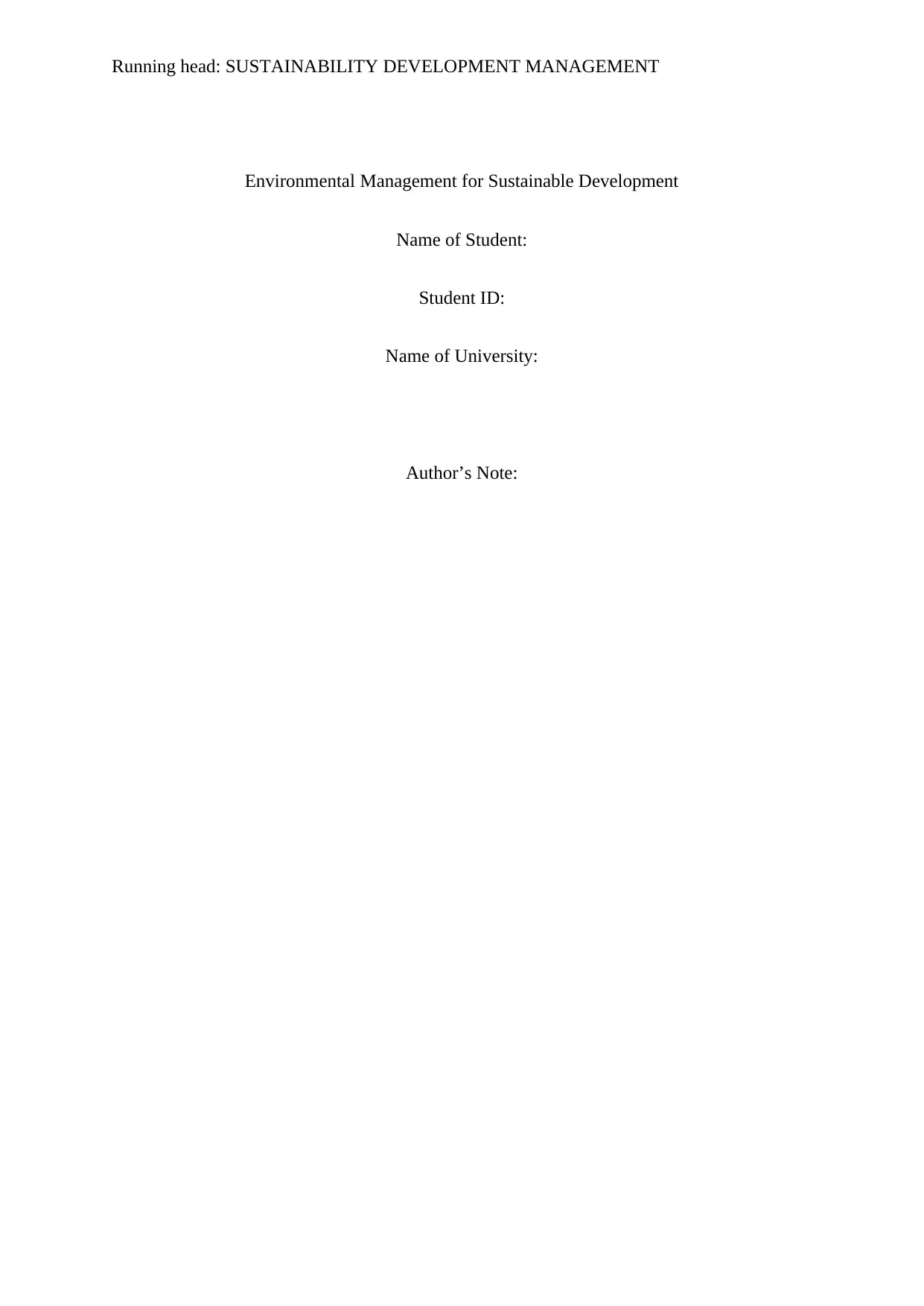
Running head: SUSTAINABILITY DEVELOPMENT MANAGEMENT
Environmental Management for Sustainable Development
Name of Student:
Student ID:
Name of University:
Author’s Note:
Environmental Management for Sustainable Development
Name of Student:
Student ID:
Name of University:
Author’s Note:
Paraphrase This Document
Need a fresh take? Get an instant paraphrase of this document with our AI Paraphraser
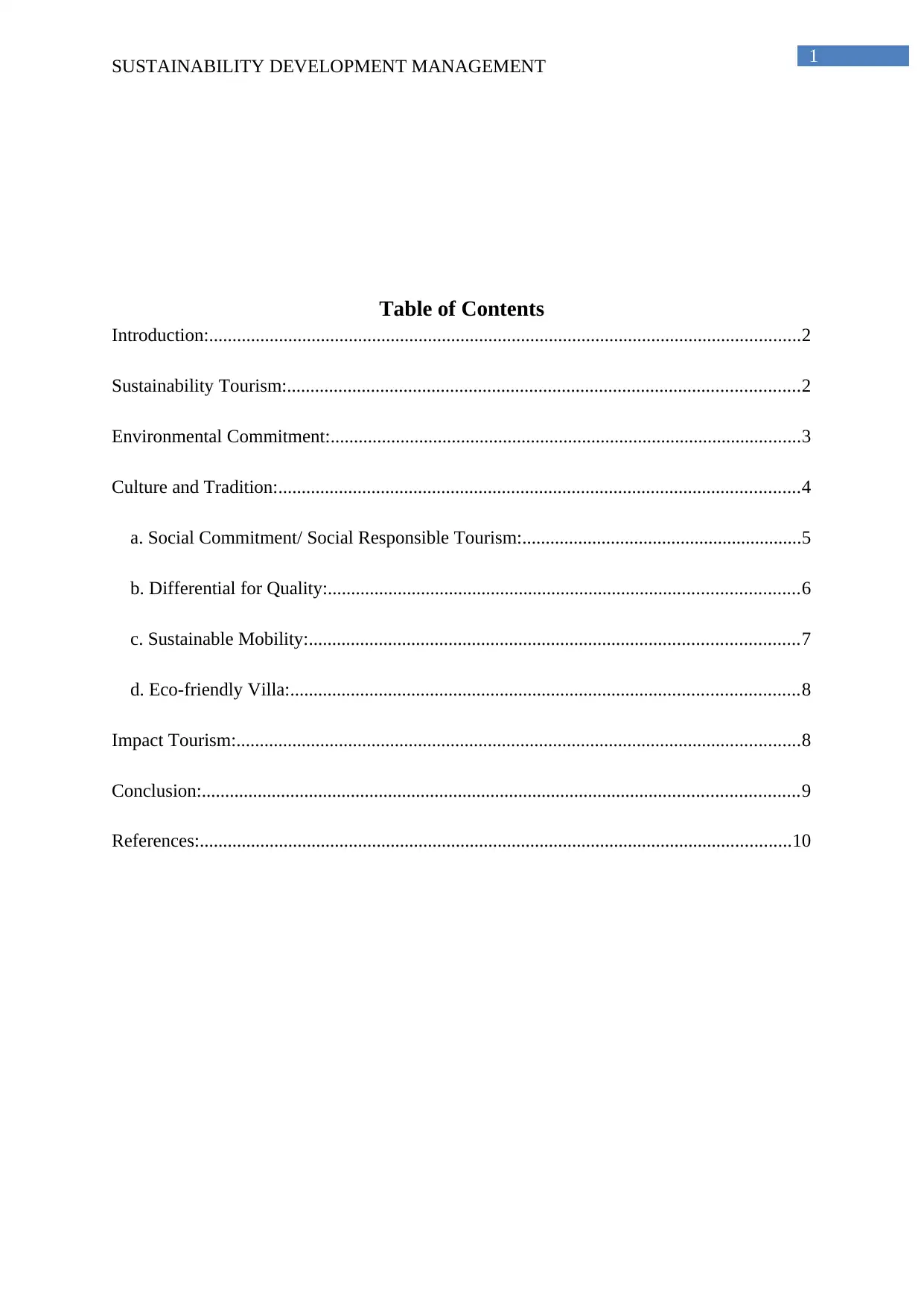
1
SUSTAINABILITY DEVELOPMENT MANAGEMENT
Table of Contents
Introduction:...............................................................................................................................2
Sustainability Tourism:..............................................................................................................2
Environmental Commitment:.....................................................................................................3
Culture and Tradition:................................................................................................................4
a. Social Commitment/ Social Responsible Tourism:............................................................5
b. Differential for Quality:.....................................................................................................6
c. Sustainable Mobility:.........................................................................................................7
d. Eco-friendly Villa:.............................................................................................................8
Impact Tourism:.........................................................................................................................8
Conclusion:................................................................................................................................9
References:...............................................................................................................................10
SUSTAINABILITY DEVELOPMENT MANAGEMENT
Table of Contents
Introduction:...............................................................................................................................2
Sustainability Tourism:..............................................................................................................2
Environmental Commitment:.....................................................................................................3
Culture and Tradition:................................................................................................................4
a. Social Commitment/ Social Responsible Tourism:............................................................5
b. Differential for Quality:.....................................................................................................6
c. Sustainable Mobility:.........................................................................................................7
d. Eco-friendly Villa:.............................................................................................................8
Impact Tourism:.........................................................................................................................8
Conclusion:................................................................................................................................9
References:...............................................................................................................................10
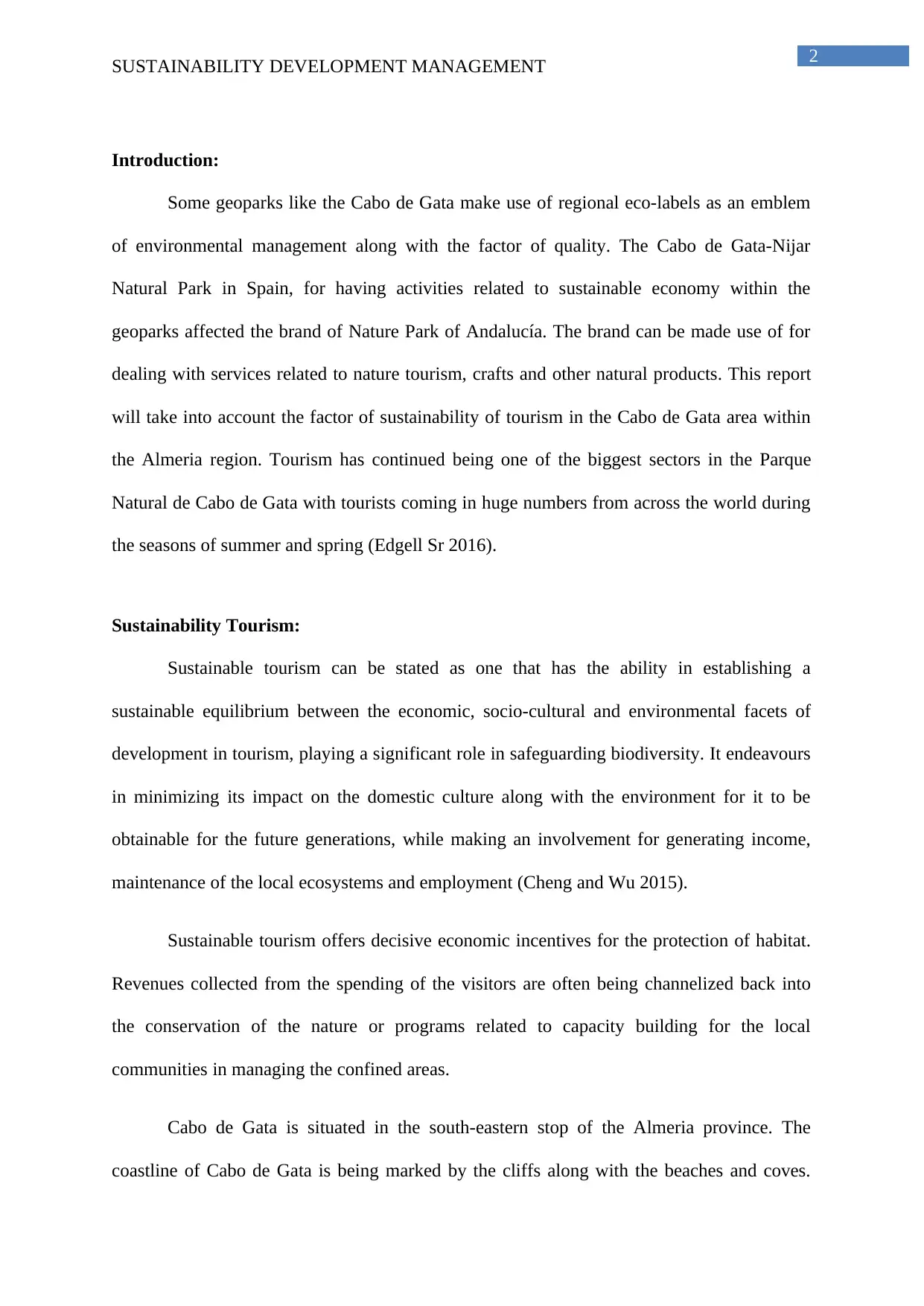
2
SUSTAINABILITY DEVELOPMENT MANAGEMENT
Introduction:
Some geoparks like the Cabo de Gata make use of regional eco-labels as an emblem
of environmental management along with the factor of quality. The Cabo de Gata-Nijar
Natural Park in Spain, for having activities related to sustainable economy within the
geoparks affected the brand of Nature Park of Andalucía. The brand can be made use of for
dealing with services related to nature tourism, crafts and other natural products. This report
will take into account the factor of sustainability of tourism in the Cabo de Gata area within
the Almeria region. Tourism has continued being one of the biggest sectors in the Parque
Natural de Cabo de Gata with tourists coming in huge numbers from across the world during
the seasons of summer and spring (Edgell Sr 2016).
Sustainability Tourism:
Sustainable tourism can be stated as one that has the ability in establishing a
sustainable equilibrium between the economic, socio-cultural and environmental facets of
development in tourism, playing a significant role in safeguarding biodiversity. It endeavours
in minimizing its impact on the domestic culture along with the environment for it to be
obtainable for the future generations, while making an involvement for generating income,
maintenance of the local ecosystems and employment (Cheng and Wu 2015).
Sustainable tourism offers decisive economic incentives for the protection of habitat.
Revenues collected from the spending of the visitors are often being channelized back into
the conservation of the nature or programs related to capacity building for the local
communities in managing the confined areas.
Cabo de Gata is situated in the south-eastern stop of the Almeria province. The
coastline of Cabo de Gata is being marked by the cliffs along with the beaches and coves.
SUSTAINABILITY DEVELOPMENT MANAGEMENT
Introduction:
Some geoparks like the Cabo de Gata make use of regional eco-labels as an emblem
of environmental management along with the factor of quality. The Cabo de Gata-Nijar
Natural Park in Spain, for having activities related to sustainable economy within the
geoparks affected the brand of Nature Park of Andalucía. The brand can be made use of for
dealing with services related to nature tourism, crafts and other natural products. This report
will take into account the factor of sustainability of tourism in the Cabo de Gata area within
the Almeria region. Tourism has continued being one of the biggest sectors in the Parque
Natural de Cabo de Gata with tourists coming in huge numbers from across the world during
the seasons of summer and spring (Edgell Sr 2016).
Sustainability Tourism:
Sustainable tourism can be stated as one that has the ability in establishing a
sustainable equilibrium between the economic, socio-cultural and environmental facets of
development in tourism, playing a significant role in safeguarding biodiversity. It endeavours
in minimizing its impact on the domestic culture along with the environment for it to be
obtainable for the future generations, while making an involvement for generating income,
maintenance of the local ecosystems and employment (Cheng and Wu 2015).
Sustainable tourism offers decisive economic incentives for the protection of habitat.
Revenues collected from the spending of the visitors are often being channelized back into
the conservation of the nature or programs related to capacity building for the local
communities in managing the confined areas.
Cabo de Gata is situated in the south-eastern stop of the Almeria province. The
coastline of Cabo de Gata is being marked by the cliffs along with the beaches and coves.
⊘ This is a preview!⊘
Do you want full access?
Subscribe today to unlock all pages.

Trusted by 1+ million students worldwide
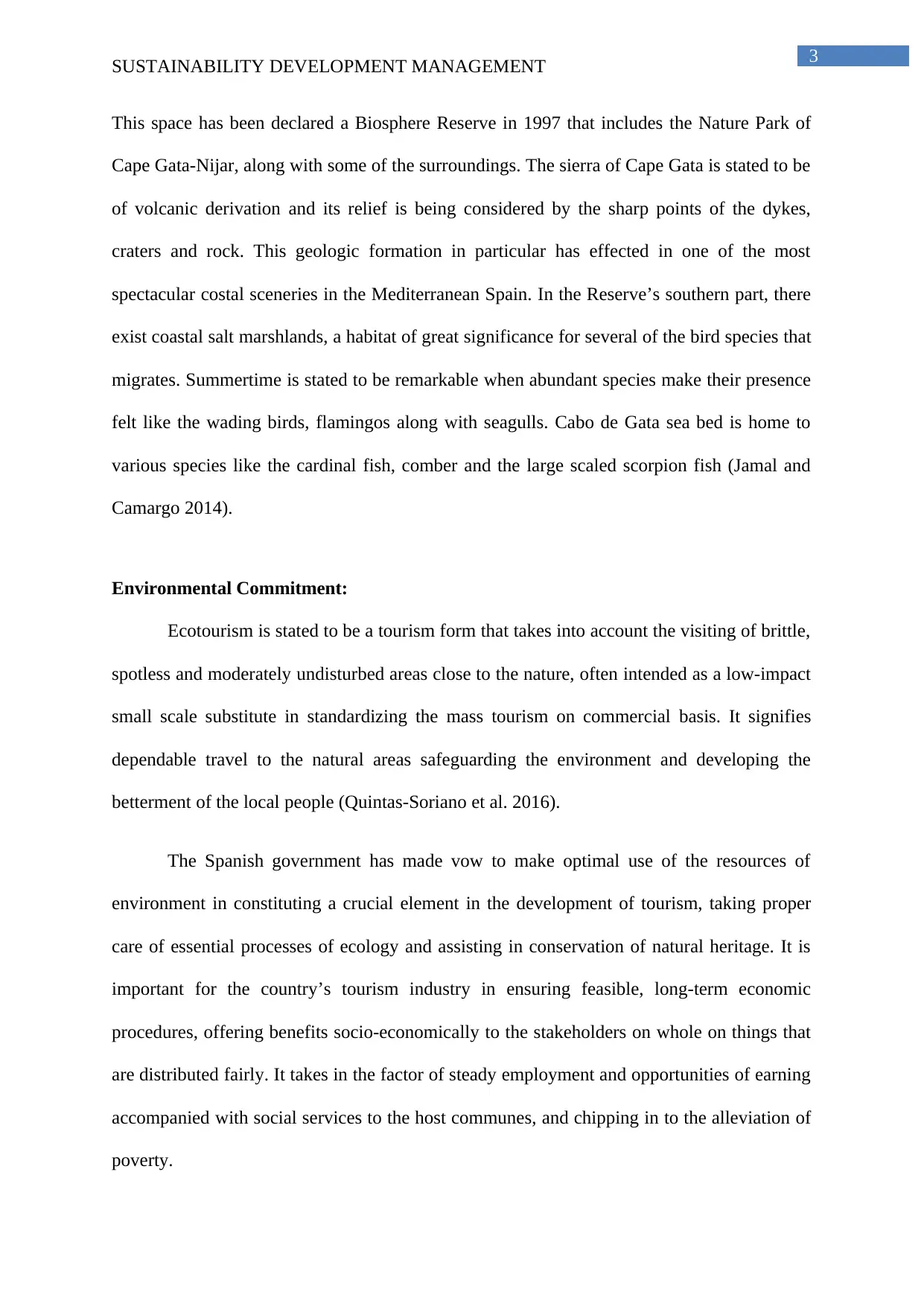
3
SUSTAINABILITY DEVELOPMENT MANAGEMENT
This space has been declared a Biosphere Reserve in 1997 that includes the Nature Park of
Cape Gata-Nijar, along with some of the surroundings. The sierra of Cape Gata is stated to be
of volcanic derivation and its relief is being considered by the sharp points of the dykes,
craters and rock. This geologic formation in particular has effected in one of the most
spectacular costal sceneries in the Mediterranean Spain. In the Reserve’s southern part, there
exist coastal salt marshlands, a habitat of great significance for several of the bird species that
migrates. Summertime is stated to be remarkable when abundant species make their presence
felt like the wading birds, flamingos along with seagulls. Cabo de Gata sea bed is home to
various species like the cardinal fish, comber and the large scaled scorpion fish (Jamal and
Camargo 2014).
Environmental Commitment:
Ecotourism is stated to be a tourism form that takes into account the visiting of brittle,
spotless and moderately undisturbed areas close to the nature, often intended as a low-impact
small scale substitute in standardizing the mass tourism on commercial basis. It signifies
dependable travel to the natural areas safeguarding the environment and developing the
betterment of the local people (Quintas-Soriano et al. 2016).
The Spanish government has made vow to make optimal use of the resources of
environment in constituting a crucial element in the development of tourism, taking proper
care of essential processes of ecology and assisting in conservation of natural heritage. It is
important for the country’s tourism industry in ensuring feasible, long-term economic
procedures, offering benefits socio-economically to the stakeholders on whole on things that
are distributed fairly. It takes in the factor of steady employment and opportunities of earning
accompanied with social services to the host communes, and chipping in to the alleviation of
poverty.
SUSTAINABILITY DEVELOPMENT MANAGEMENT
This space has been declared a Biosphere Reserve in 1997 that includes the Nature Park of
Cape Gata-Nijar, along with some of the surroundings. The sierra of Cape Gata is stated to be
of volcanic derivation and its relief is being considered by the sharp points of the dykes,
craters and rock. This geologic formation in particular has effected in one of the most
spectacular costal sceneries in the Mediterranean Spain. In the Reserve’s southern part, there
exist coastal salt marshlands, a habitat of great significance for several of the bird species that
migrates. Summertime is stated to be remarkable when abundant species make their presence
felt like the wading birds, flamingos along with seagulls. Cabo de Gata sea bed is home to
various species like the cardinal fish, comber and the large scaled scorpion fish (Jamal and
Camargo 2014).
Environmental Commitment:
Ecotourism is stated to be a tourism form that takes into account the visiting of brittle,
spotless and moderately undisturbed areas close to the nature, often intended as a low-impact
small scale substitute in standardizing the mass tourism on commercial basis. It signifies
dependable travel to the natural areas safeguarding the environment and developing the
betterment of the local people (Quintas-Soriano et al. 2016).
The Spanish government has made vow to make optimal use of the resources of
environment in constituting a crucial element in the development of tourism, taking proper
care of essential processes of ecology and assisting in conservation of natural heritage. It is
important for the country’s tourism industry in ensuring feasible, long-term economic
procedures, offering benefits socio-economically to the stakeholders on whole on things that
are distributed fairly. It takes in the factor of steady employment and opportunities of earning
accompanied with social services to the host communes, and chipping in to the alleviation of
poverty.
Paraphrase This Document
Need a fresh take? Get an instant paraphrase of this document with our AI Paraphraser
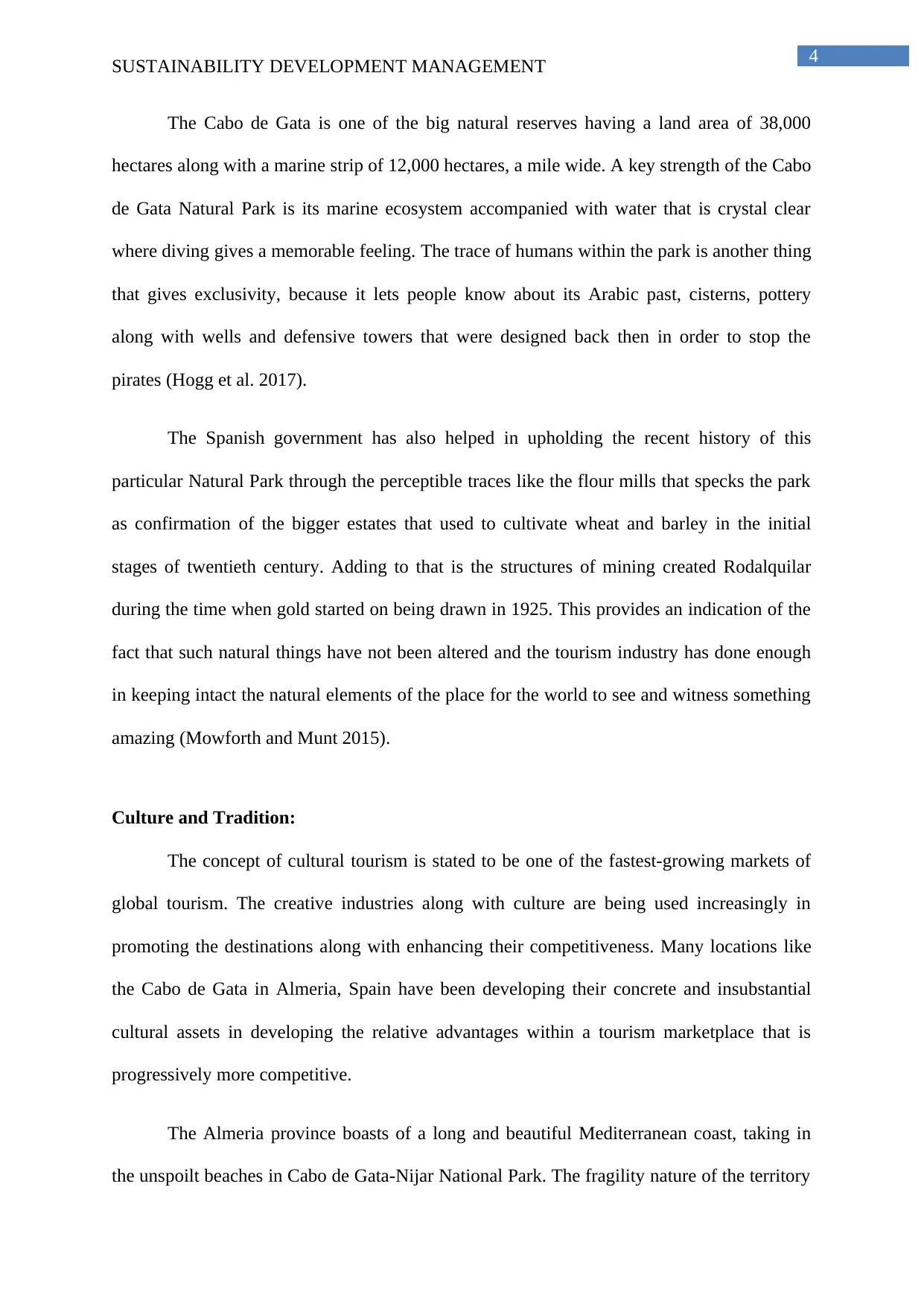
4
SUSTAINABILITY DEVELOPMENT MANAGEMENT
The Cabo de Gata is one of the big natural reserves having a land area of 38,000
hectares along with a marine strip of 12,000 hectares, a mile wide. A key strength of the Cabo
de Gata Natural Park is its marine ecosystem accompanied with water that is crystal clear
where diving gives a memorable feeling. The trace of humans within the park is another thing
that gives exclusivity, because it lets people know about its Arabic past, cisterns, pottery
along with wells and defensive towers that were designed back then in order to stop the
pirates (Hogg et al. 2017).
The Spanish government has also helped in upholding the recent history of this
particular Natural Park through the perceptible traces like the flour mills that specks the park
as confirmation of the bigger estates that used to cultivate wheat and barley in the initial
stages of twentieth century. Adding to that is the structures of mining created Rodalquilar
during the time when gold started on being drawn in 1925. This provides an indication of the
fact that such natural things have not been altered and the tourism industry has done enough
in keeping intact the natural elements of the place for the world to see and witness something
amazing (Mowforth and Munt 2015).
Culture and Tradition:
The concept of cultural tourism is stated to be one of the fastest-growing markets of
global tourism. The creative industries along with culture are being used increasingly in
promoting the destinations along with enhancing their competitiveness. Many locations like
the Cabo de Gata in Almeria, Spain have been developing their concrete and insubstantial
cultural assets in developing the relative advantages within a tourism marketplace that is
progressively more competitive.
The Almeria province boasts of a long and beautiful Mediterranean coast, taking in
the unspoilt beaches in Cabo de Gata-Nijar National Park. The fragility nature of the territory
SUSTAINABILITY DEVELOPMENT MANAGEMENT
The Cabo de Gata is one of the big natural reserves having a land area of 38,000
hectares along with a marine strip of 12,000 hectares, a mile wide. A key strength of the Cabo
de Gata Natural Park is its marine ecosystem accompanied with water that is crystal clear
where diving gives a memorable feeling. The trace of humans within the park is another thing
that gives exclusivity, because it lets people know about its Arabic past, cisterns, pottery
along with wells and defensive towers that were designed back then in order to stop the
pirates (Hogg et al. 2017).
The Spanish government has also helped in upholding the recent history of this
particular Natural Park through the perceptible traces like the flour mills that specks the park
as confirmation of the bigger estates that used to cultivate wheat and barley in the initial
stages of twentieth century. Adding to that is the structures of mining created Rodalquilar
during the time when gold started on being drawn in 1925. This provides an indication of the
fact that such natural things have not been altered and the tourism industry has done enough
in keeping intact the natural elements of the place for the world to see and witness something
amazing (Mowforth and Munt 2015).
Culture and Tradition:
The concept of cultural tourism is stated to be one of the fastest-growing markets of
global tourism. The creative industries along with culture are being used increasingly in
promoting the destinations along with enhancing their competitiveness. Many locations like
the Cabo de Gata in Almeria, Spain have been developing their concrete and insubstantial
cultural assets in developing the relative advantages within a tourism marketplace that is
progressively more competitive.
The Almeria province boasts of a long and beautiful Mediterranean coast, taking in
the unspoilt beaches in Cabo de Gata-Nijar National Park. The fragility nature of the territory
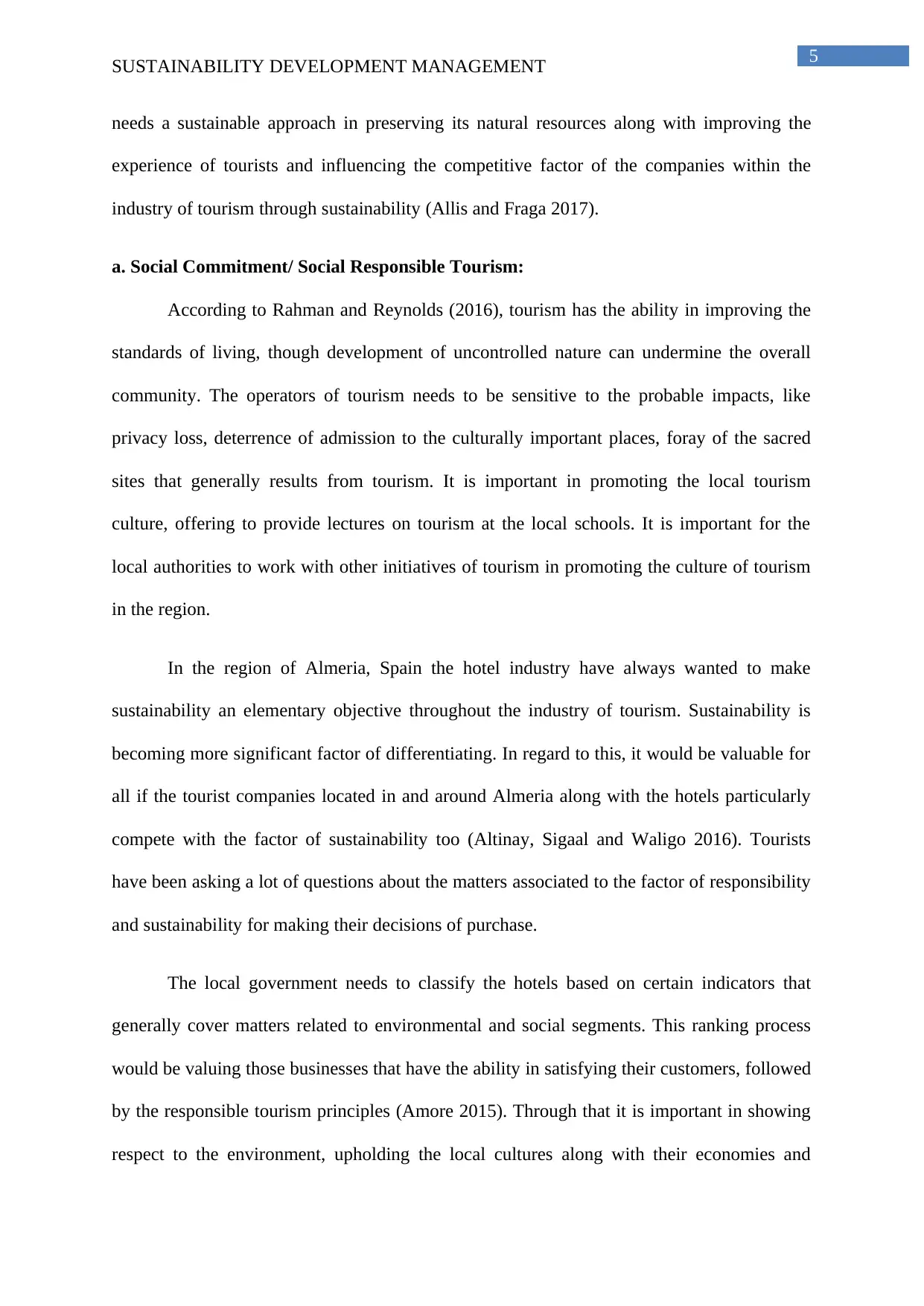
5
SUSTAINABILITY DEVELOPMENT MANAGEMENT
needs a sustainable approach in preserving its natural resources along with improving the
experience of tourists and influencing the competitive factor of the companies within the
industry of tourism through sustainability (Allis and Fraga 2017).
a. Social Commitment/ Social Responsible Tourism:
According to Rahman and Reynolds (2016), tourism has the ability in improving the
standards of living, though development of uncontrolled nature can undermine the overall
community. The operators of tourism needs to be sensitive to the probable impacts, like
privacy loss, deterrence of admission to the culturally important places, foray of the sacred
sites that generally results from tourism. It is important in promoting the local tourism
culture, offering to provide lectures on tourism at the local schools. It is important for the
local authorities to work with other initiatives of tourism in promoting the culture of tourism
in the region.
In the region of Almeria, Spain the hotel industry have always wanted to make
sustainability an elementary objective throughout the industry of tourism. Sustainability is
becoming more significant factor of differentiating. In regard to this, it would be valuable for
all if the tourist companies located in and around Almeria along with the hotels particularly
compete with the factor of sustainability too (Altinay, Sigaal and Waligo 2016). Tourists
have been asking a lot of questions about the matters associated to the factor of responsibility
and sustainability for making their decisions of purchase.
The local government needs to classify the hotels based on certain indicators that
generally cover matters related to environmental and social segments. This ranking process
would be valuing those businesses that have the ability in satisfying their customers, followed
by the responsible tourism principles (Amore 2015). Through that it is important in showing
respect to the environment, upholding the local cultures along with their economies and
SUSTAINABILITY DEVELOPMENT MANAGEMENT
needs a sustainable approach in preserving its natural resources along with improving the
experience of tourists and influencing the competitive factor of the companies within the
industry of tourism through sustainability (Allis and Fraga 2017).
a. Social Commitment/ Social Responsible Tourism:
According to Rahman and Reynolds (2016), tourism has the ability in improving the
standards of living, though development of uncontrolled nature can undermine the overall
community. The operators of tourism needs to be sensitive to the probable impacts, like
privacy loss, deterrence of admission to the culturally important places, foray of the sacred
sites that generally results from tourism. It is important in promoting the local tourism
culture, offering to provide lectures on tourism at the local schools. It is important for the
local authorities to work with other initiatives of tourism in promoting the culture of tourism
in the region.
In the region of Almeria, Spain the hotel industry have always wanted to make
sustainability an elementary objective throughout the industry of tourism. Sustainability is
becoming more significant factor of differentiating. In regard to this, it would be valuable for
all if the tourist companies located in and around Almeria along with the hotels particularly
compete with the factor of sustainability too (Altinay, Sigaal and Waligo 2016). Tourists
have been asking a lot of questions about the matters associated to the factor of responsibility
and sustainability for making their decisions of purchase.
The local government needs to classify the hotels based on certain indicators that
generally cover matters related to environmental and social segments. This ranking process
would be valuing those businesses that have the ability in satisfying their customers, followed
by the responsible tourism principles (Amore 2015). Through that it is important in showing
respect to the environment, upholding the local cultures along with their economies and
⊘ This is a preview!⊘
Do you want full access?
Subscribe today to unlock all pages.

Trusted by 1+ million students worldwide
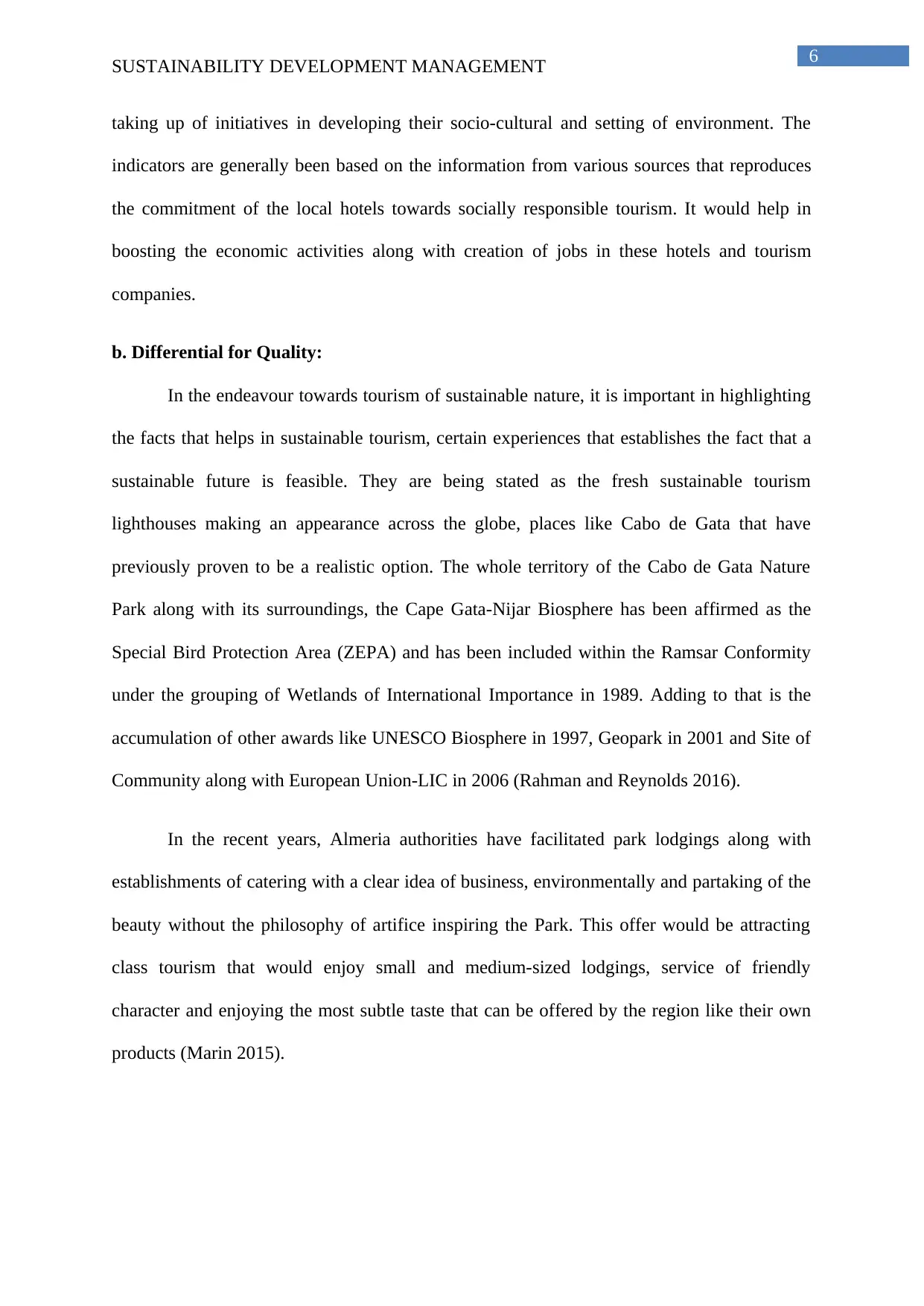
6
SUSTAINABILITY DEVELOPMENT MANAGEMENT
taking up of initiatives in developing their socio-cultural and setting of environment. The
indicators are generally been based on the information from various sources that reproduces
the commitment of the local hotels towards socially responsible tourism. It would help in
boosting the economic activities along with creation of jobs in these hotels and tourism
companies.
b. Differential for Quality:
In the endeavour towards tourism of sustainable nature, it is important in highlighting
the facts that helps in sustainable tourism, certain experiences that establishes the fact that a
sustainable future is feasible. They are being stated as the fresh sustainable tourism
lighthouses making an appearance across the globe, places like Cabo de Gata that have
previously proven to be a realistic option. The whole territory of the Cabo de Gata Nature
Park along with its surroundings, the Cape Gata-Nijar Biosphere has been affirmed as the
Special Bird Protection Area (ZEPA) and has been included within the Ramsar Conformity
under the grouping of Wetlands of International Importance in 1989. Adding to that is the
accumulation of other awards like UNESCO Biosphere in 1997, Geopark in 2001 and Site of
Community along with European Union-LIC in 2006 (Rahman and Reynolds 2016).
In the recent years, Almeria authorities have facilitated park lodgings along with
establishments of catering with a clear idea of business, environmentally and partaking of the
beauty without the philosophy of artifice inspiring the Park. This offer would be attracting
class tourism that would enjoy small and medium-sized lodgings, service of friendly
character and enjoying the most subtle taste that can be offered by the region like their own
products (Marin 2015).
SUSTAINABILITY DEVELOPMENT MANAGEMENT
taking up of initiatives in developing their socio-cultural and setting of environment. The
indicators are generally been based on the information from various sources that reproduces
the commitment of the local hotels towards socially responsible tourism. It would help in
boosting the economic activities along with creation of jobs in these hotels and tourism
companies.
b. Differential for Quality:
In the endeavour towards tourism of sustainable nature, it is important in highlighting
the facts that helps in sustainable tourism, certain experiences that establishes the fact that a
sustainable future is feasible. They are being stated as the fresh sustainable tourism
lighthouses making an appearance across the globe, places like Cabo de Gata that have
previously proven to be a realistic option. The whole territory of the Cabo de Gata Nature
Park along with its surroundings, the Cape Gata-Nijar Biosphere has been affirmed as the
Special Bird Protection Area (ZEPA) and has been included within the Ramsar Conformity
under the grouping of Wetlands of International Importance in 1989. Adding to that is the
accumulation of other awards like UNESCO Biosphere in 1997, Geopark in 2001 and Site of
Community along with European Union-LIC in 2006 (Rahman and Reynolds 2016).
In the recent years, Almeria authorities have facilitated park lodgings along with
establishments of catering with a clear idea of business, environmentally and partaking of the
beauty without the philosophy of artifice inspiring the Park. This offer would be attracting
class tourism that would enjoy small and medium-sized lodgings, service of friendly
character and enjoying the most subtle taste that can be offered by the region like their own
products (Marin 2015).
Paraphrase This Document
Need a fresh take? Get an instant paraphrase of this document with our AI Paraphraser
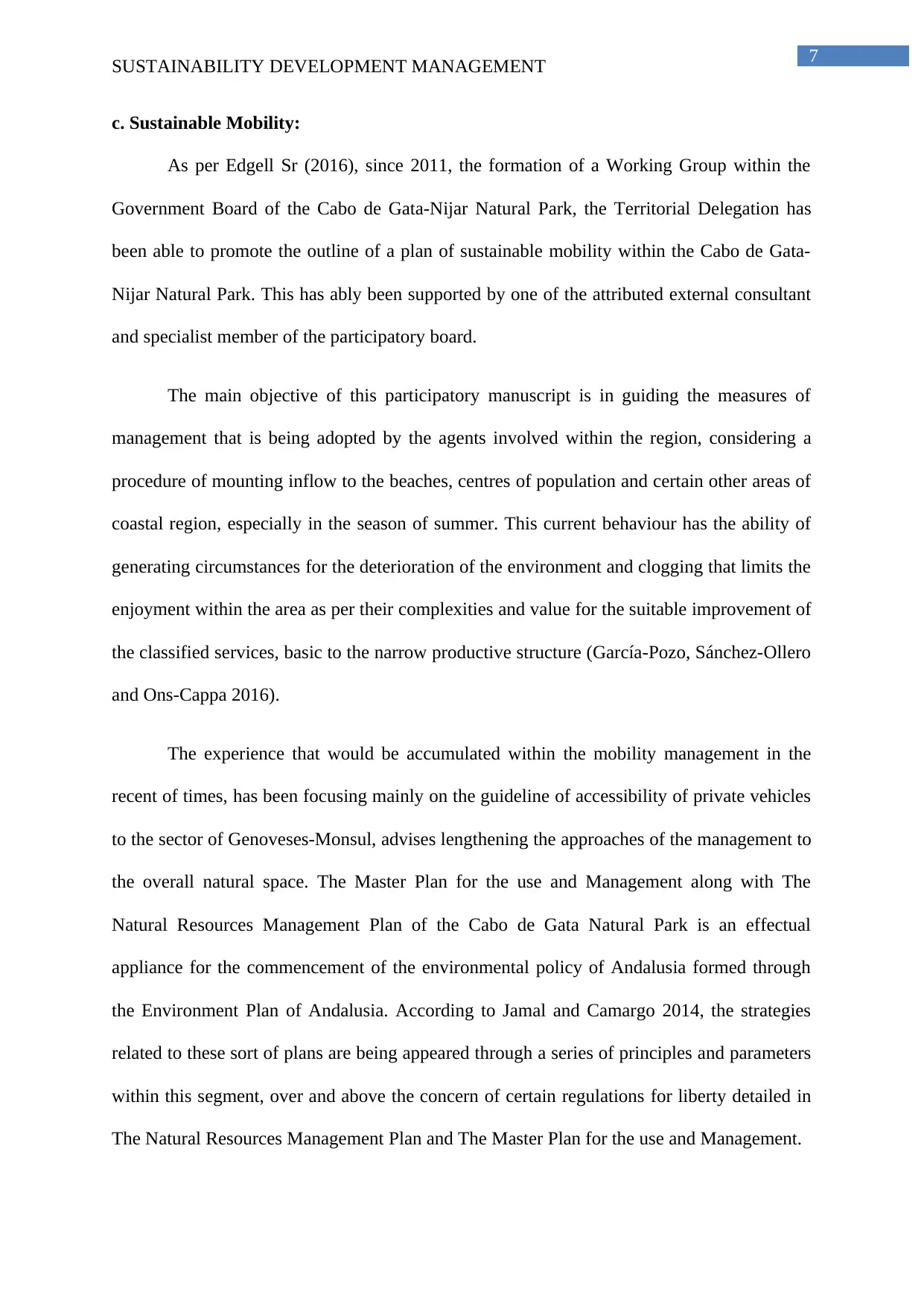
7
SUSTAINABILITY DEVELOPMENT MANAGEMENT
c. Sustainable Mobility:
As per Edgell Sr (2016), since 2011, the formation of a Working Group within the
Government Board of the Cabo de Gata-Nijar Natural Park, the Territorial Delegation has
been able to promote the outline of a plan of sustainable mobility within the Cabo de Gata-
Nijar Natural Park. This has ably been supported by one of the attributed external consultant
and specialist member of the participatory board.
The main objective of this participatory manuscript is in guiding the measures of
management that is being adopted by the agents involved within the region, considering a
procedure of mounting inflow to the beaches, centres of population and certain other areas of
coastal region, especially in the season of summer. This current behaviour has the ability of
generating circumstances for the deterioration of the environment and clogging that limits the
enjoyment within the area as per their complexities and value for the suitable improvement of
the classified services, basic to the narrow productive structure (García-Pozo, Sánchez-Ollero
and Ons-Cappa 2016).
The experience that would be accumulated within the mobility management in the
recent of times, has been focusing mainly on the guideline of accessibility of private vehicles
to the sector of Genoveses-Monsul, advises lengthening the approaches of the management to
the overall natural space. The Master Plan for the use and Management along with The
Natural Resources Management Plan of the Cabo de Gata Natural Park is an effectual
appliance for the commencement of the environmental policy of Andalusia formed through
the Environment Plan of Andalusia. According to Jamal and Camargo 2014, the strategies
related to these sort of plans are being appeared through a series of principles and parameters
within this segment, over and above the concern of certain regulations for liberty detailed in
The Natural Resources Management Plan and The Master Plan for the use and Management.
SUSTAINABILITY DEVELOPMENT MANAGEMENT
c. Sustainable Mobility:
As per Edgell Sr (2016), since 2011, the formation of a Working Group within the
Government Board of the Cabo de Gata-Nijar Natural Park, the Territorial Delegation has
been able to promote the outline of a plan of sustainable mobility within the Cabo de Gata-
Nijar Natural Park. This has ably been supported by one of the attributed external consultant
and specialist member of the participatory board.
The main objective of this participatory manuscript is in guiding the measures of
management that is being adopted by the agents involved within the region, considering a
procedure of mounting inflow to the beaches, centres of population and certain other areas of
coastal region, especially in the season of summer. This current behaviour has the ability of
generating circumstances for the deterioration of the environment and clogging that limits the
enjoyment within the area as per their complexities and value for the suitable improvement of
the classified services, basic to the narrow productive structure (García-Pozo, Sánchez-Ollero
and Ons-Cappa 2016).
The experience that would be accumulated within the mobility management in the
recent of times, has been focusing mainly on the guideline of accessibility of private vehicles
to the sector of Genoveses-Monsul, advises lengthening the approaches of the management to
the overall natural space. The Master Plan for the use and Management along with The
Natural Resources Management Plan of the Cabo de Gata Natural Park is an effectual
appliance for the commencement of the environmental policy of Andalusia formed through
the Environment Plan of Andalusia. According to Jamal and Camargo 2014, the strategies
related to these sort of plans are being appeared through a series of principles and parameters
within this segment, over and above the concern of certain regulations for liberty detailed in
The Natural Resources Management Plan and The Master Plan for the use and Management.
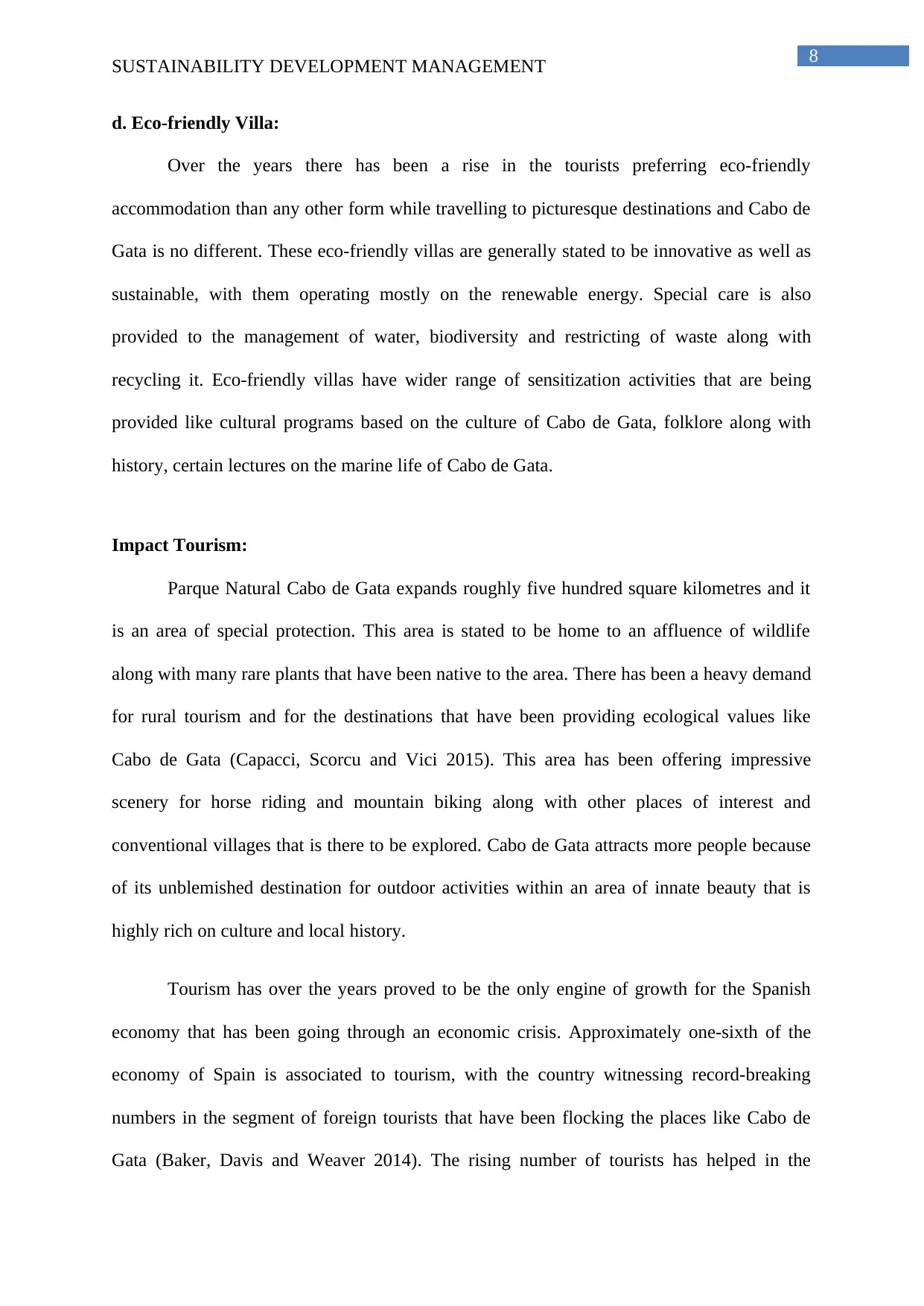
8
SUSTAINABILITY DEVELOPMENT MANAGEMENT
d. Eco-friendly Villa:
Over the years there has been a rise in the tourists preferring eco-friendly
accommodation than any other form while travelling to picturesque destinations and Cabo de
Gata is no different. These eco-friendly villas are generally stated to be innovative as well as
sustainable, with them operating mostly on the renewable energy. Special care is also
provided to the management of water, biodiversity and restricting of waste along with
recycling it. Eco-friendly villas have wider range of sensitization activities that are being
provided like cultural programs based on the culture of Cabo de Gata, folklore along with
history, certain lectures on the marine life of Cabo de Gata.
Impact Tourism:
Parque Natural Cabo de Gata expands roughly five hundred square kilometres and it
is an area of special protection. This area is stated to be home to an affluence of wildlife
along with many rare plants that have been native to the area. There has been a heavy demand
for rural tourism and for the destinations that have been providing ecological values like
Cabo de Gata (Capacci, Scorcu and Vici 2015). This area has been offering impressive
scenery for horse riding and mountain biking along with other places of interest and
conventional villages that is there to be explored. Cabo de Gata attracts more people because
of its unblemished destination for outdoor activities within an area of innate beauty that is
highly rich on culture and local history.
Tourism has over the years proved to be the only engine of growth for the Spanish
economy that has been going through an economic crisis. Approximately one-sixth of the
economy of Spain is associated to tourism, with the country witnessing record-breaking
numbers in the segment of foreign tourists that have been flocking the places like Cabo de
Gata (Baker, Davis and Weaver 2014). The rising number of tourists has helped in the
SUSTAINABILITY DEVELOPMENT MANAGEMENT
d. Eco-friendly Villa:
Over the years there has been a rise in the tourists preferring eco-friendly
accommodation than any other form while travelling to picturesque destinations and Cabo de
Gata is no different. These eco-friendly villas are generally stated to be innovative as well as
sustainable, with them operating mostly on the renewable energy. Special care is also
provided to the management of water, biodiversity and restricting of waste along with
recycling it. Eco-friendly villas have wider range of sensitization activities that are being
provided like cultural programs based on the culture of Cabo de Gata, folklore along with
history, certain lectures on the marine life of Cabo de Gata.
Impact Tourism:
Parque Natural Cabo de Gata expands roughly five hundred square kilometres and it
is an area of special protection. This area is stated to be home to an affluence of wildlife
along with many rare plants that have been native to the area. There has been a heavy demand
for rural tourism and for the destinations that have been providing ecological values like
Cabo de Gata (Capacci, Scorcu and Vici 2015). This area has been offering impressive
scenery for horse riding and mountain biking along with other places of interest and
conventional villages that is there to be explored. Cabo de Gata attracts more people because
of its unblemished destination for outdoor activities within an area of innate beauty that is
highly rich on culture and local history.
Tourism has over the years proved to be the only engine of growth for the Spanish
economy that has been going through an economic crisis. Approximately one-sixth of the
economy of Spain is associated to tourism, with the country witnessing record-breaking
numbers in the segment of foreign tourists that have been flocking the places like Cabo de
Gata (Baker, Davis and Weaver 2014). The rising number of tourists has helped in the
⊘ This is a preview!⊘
Do you want full access?
Subscribe today to unlock all pages.

Trusted by 1+ million students worldwide
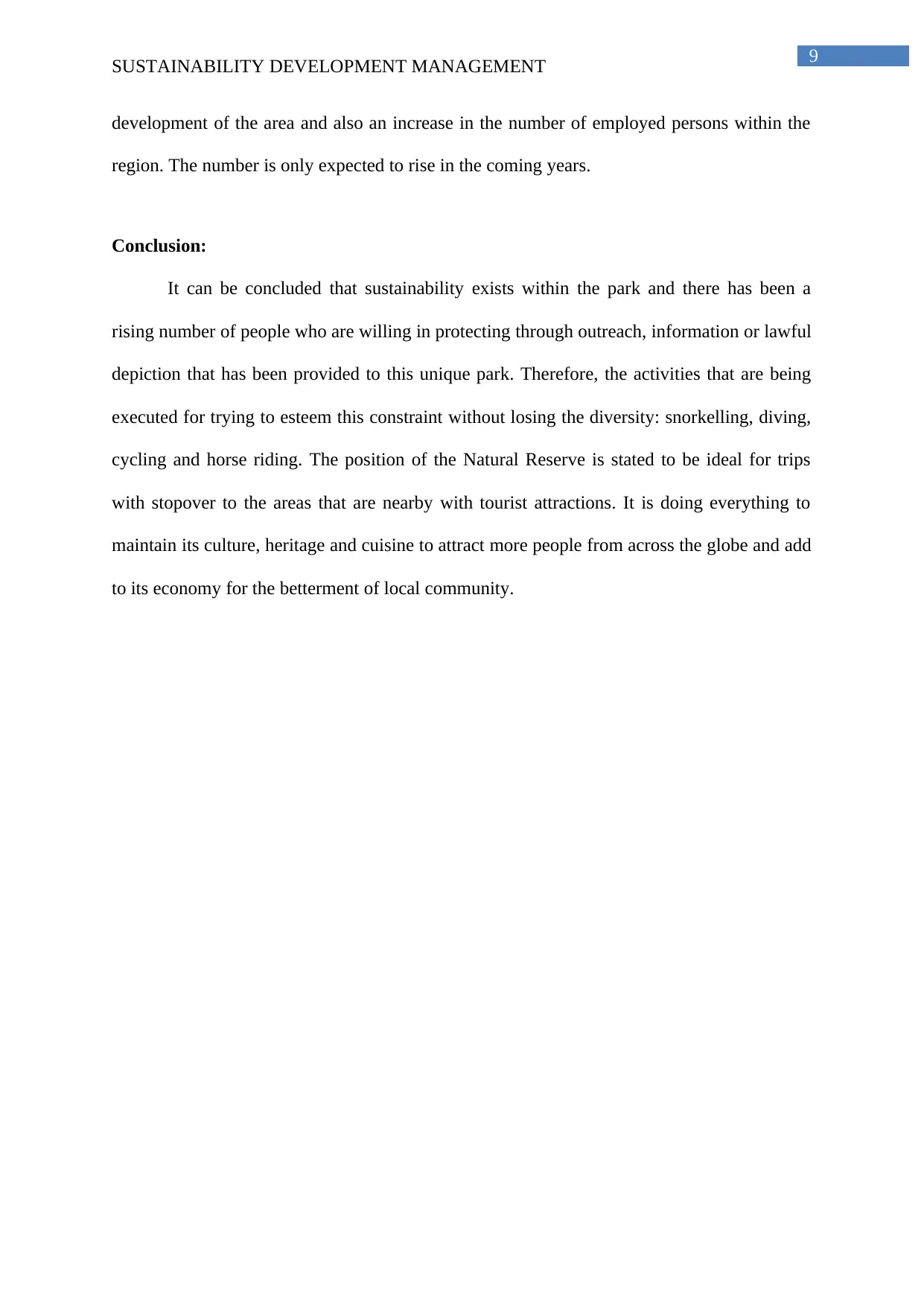
9
SUSTAINABILITY DEVELOPMENT MANAGEMENT
development of the area and also an increase in the number of employed persons within the
region. The number is only expected to rise in the coming years.
Conclusion:
It can be concluded that sustainability exists within the park and there has been a
rising number of people who are willing in protecting through outreach, information or lawful
depiction that has been provided to this unique park. Therefore, the activities that are being
executed for trying to esteem this constraint without losing the diversity: snorkelling, diving,
cycling and horse riding. The position of the Natural Reserve is stated to be ideal for trips
with stopover to the areas that are nearby with tourist attractions. It is doing everything to
maintain its culture, heritage and cuisine to attract more people from across the globe and add
to its economy for the betterment of local community.
SUSTAINABILITY DEVELOPMENT MANAGEMENT
development of the area and also an increase in the number of employed persons within the
region. The number is only expected to rise in the coming years.
Conclusion:
It can be concluded that sustainability exists within the park and there has been a
rising number of people who are willing in protecting through outreach, information or lawful
depiction that has been provided to this unique park. Therefore, the activities that are being
executed for trying to esteem this constraint without losing the diversity: snorkelling, diving,
cycling and horse riding. The position of the Natural Reserve is stated to be ideal for trips
with stopover to the areas that are nearby with tourist attractions. It is doing everything to
maintain its culture, heritage and cuisine to attract more people from across the globe and add
to its economy for the betterment of local community.
Paraphrase This Document
Need a fresh take? Get an instant paraphrase of this document with our AI Paraphraser
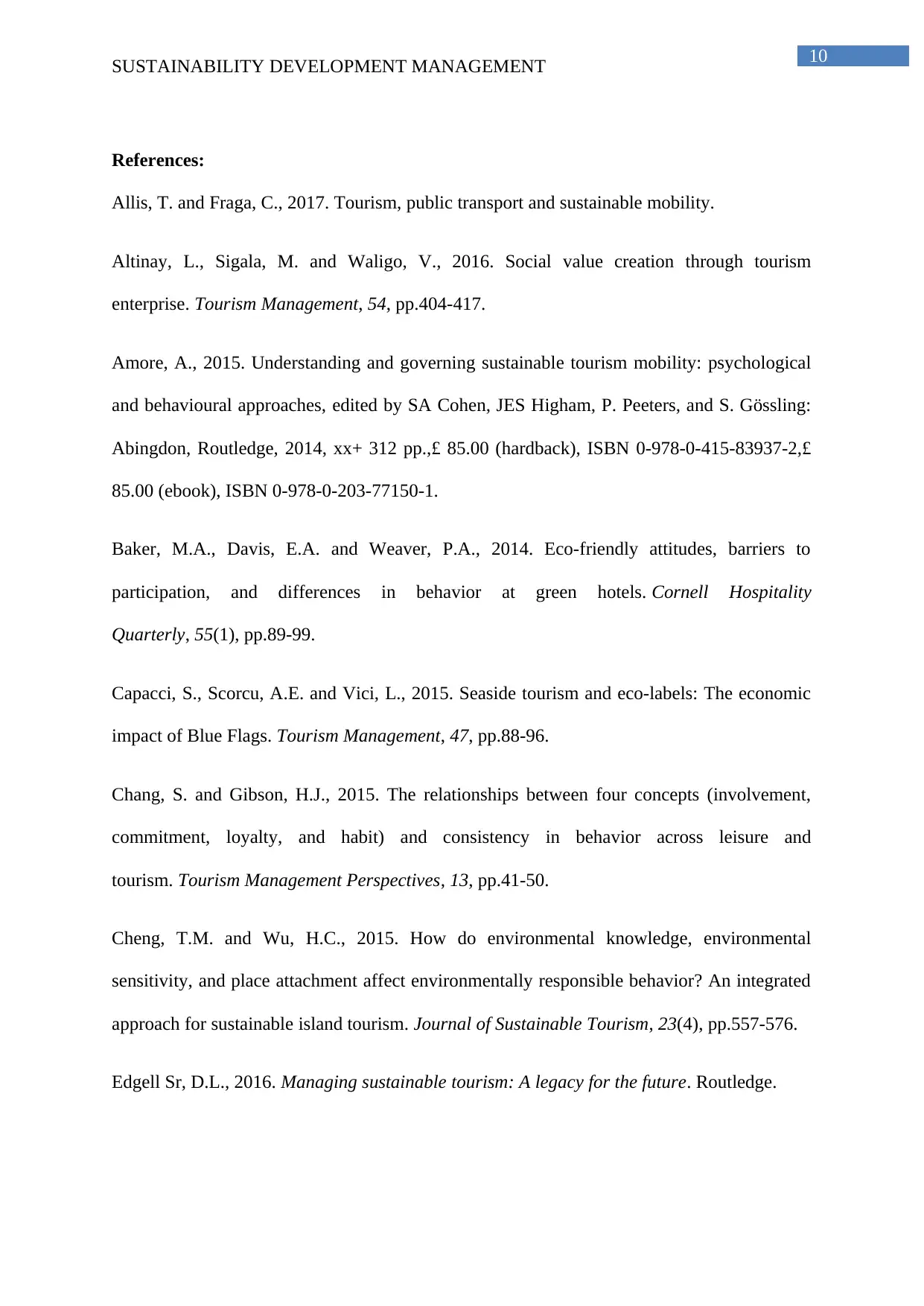
10
SUSTAINABILITY DEVELOPMENT MANAGEMENT
References:
Allis, T. and Fraga, C., 2017. Tourism, public transport and sustainable mobility.
Altinay, L., Sigala, M. and Waligo, V., 2016. Social value creation through tourism
enterprise. Tourism Management, 54, pp.404-417.
Amore, A., 2015. Understanding and governing sustainable tourism mobility: psychological
and behavioural approaches, edited by SA Cohen, JES Higham, P. Peeters, and S. Gössling:
Abingdon, Routledge, 2014, xx+ 312 pp.,£ 85.00 (hardback), ISBN 0-978-0-415-83937-2,£
85.00 (ebook), ISBN 0-978-0-203-77150-1.
Baker, M.A., Davis, E.A. and Weaver, P.A., 2014. Eco-friendly attitudes, barriers to
participation, and differences in behavior at green hotels. Cornell Hospitality
Quarterly, 55(1), pp.89-99.
Capacci, S., Scorcu, A.E. and Vici, L., 2015. Seaside tourism and eco-labels: The economic
impact of Blue Flags. Tourism Management, 47, pp.88-96.
Chang, S. and Gibson, H.J., 2015. The relationships between four concepts (involvement,
commitment, loyalty, and habit) and consistency in behavior across leisure and
tourism. Tourism Management Perspectives, 13, pp.41-50.
Cheng, T.M. and Wu, H.C., 2015. How do environmental knowledge, environmental
sensitivity, and place attachment affect environmentally responsible behavior? An integrated
approach for sustainable island tourism. Journal of Sustainable Tourism, 23(4), pp.557-576.
Edgell Sr, D.L., 2016. Managing sustainable tourism: A legacy for the future. Routledge.
SUSTAINABILITY DEVELOPMENT MANAGEMENT
References:
Allis, T. and Fraga, C., 2017. Tourism, public transport and sustainable mobility.
Altinay, L., Sigala, M. and Waligo, V., 2016. Social value creation through tourism
enterprise. Tourism Management, 54, pp.404-417.
Amore, A., 2015. Understanding and governing sustainable tourism mobility: psychological
and behavioural approaches, edited by SA Cohen, JES Higham, P. Peeters, and S. Gössling:
Abingdon, Routledge, 2014, xx+ 312 pp.,£ 85.00 (hardback), ISBN 0-978-0-415-83937-2,£
85.00 (ebook), ISBN 0-978-0-203-77150-1.
Baker, M.A., Davis, E.A. and Weaver, P.A., 2014. Eco-friendly attitudes, barriers to
participation, and differences in behavior at green hotels. Cornell Hospitality
Quarterly, 55(1), pp.89-99.
Capacci, S., Scorcu, A.E. and Vici, L., 2015. Seaside tourism and eco-labels: The economic
impact of Blue Flags. Tourism Management, 47, pp.88-96.
Chang, S. and Gibson, H.J., 2015. The relationships between four concepts (involvement,
commitment, loyalty, and habit) and consistency in behavior across leisure and
tourism. Tourism Management Perspectives, 13, pp.41-50.
Cheng, T.M. and Wu, H.C., 2015. How do environmental knowledge, environmental
sensitivity, and place attachment affect environmentally responsible behavior? An integrated
approach for sustainable island tourism. Journal of Sustainable Tourism, 23(4), pp.557-576.
Edgell Sr, D.L., 2016. Managing sustainable tourism: A legacy for the future. Routledge.
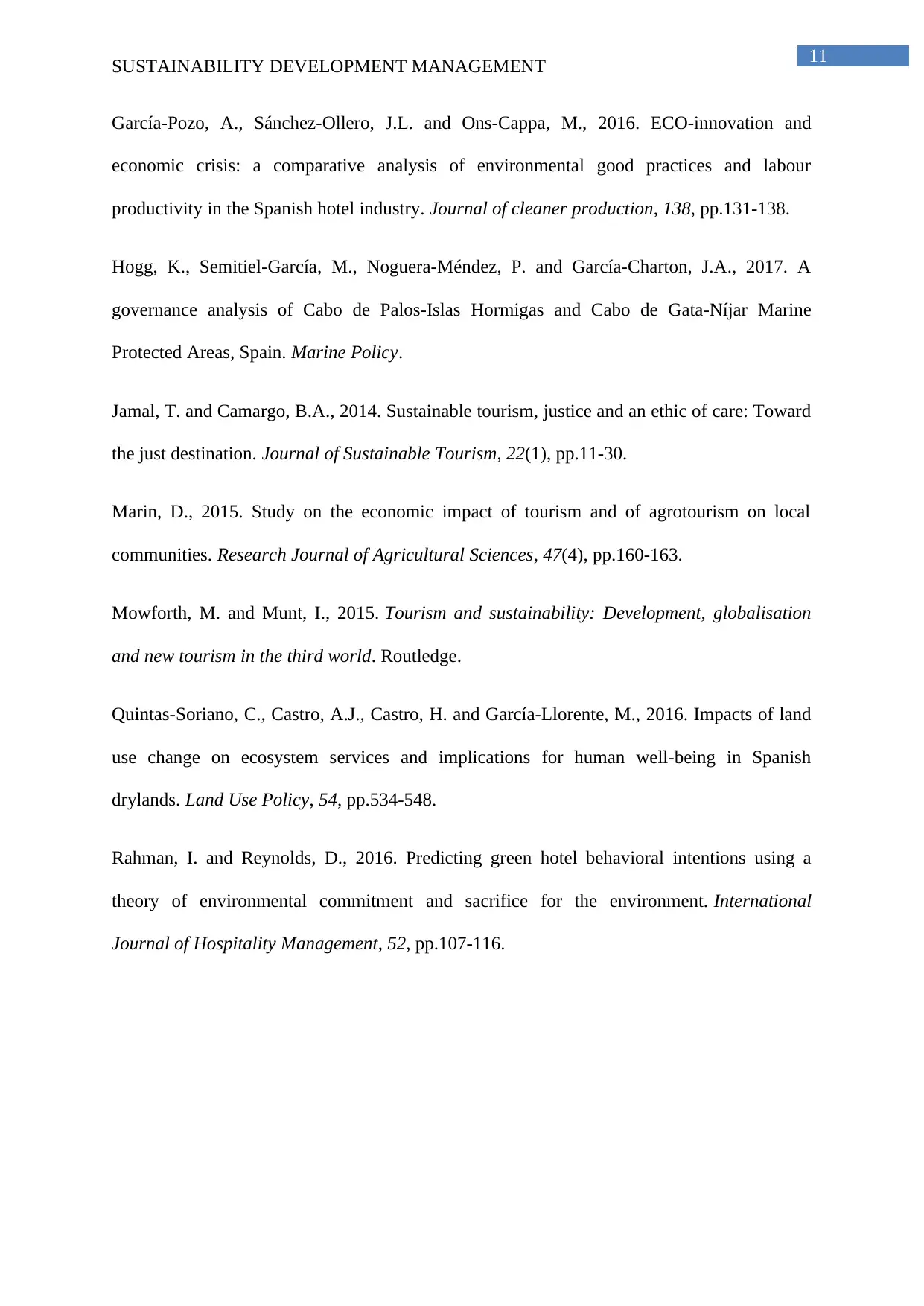
11
SUSTAINABILITY DEVELOPMENT MANAGEMENT
García-Pozo, A., Sánchez-Ollero, J.L. and Ons-Cappa, M., 2016. ECO-innovation and
economic crisis: a comparative analysis of environmental good practices and labour
productivity in the Spanish hotel industry. Journal of cleaner production, 138, pp.131-138.
Hogg, K., Semitiel-García, M., Noguera-Méndez, P. and García-Charton, J.A., 2017. A
governance analysis of Cabo de Palos-Islas Hormigas and Cabo de Gata-Níjar Marine
Protected Areas, Spain. Marine Policy.
Jamal, T. and Camargo, B.A., 2014. Sustainable tourism, justice and an ethic of care: Toward
the just destination. Journal of Sustainable Tourism, 22(1), pp.11-30.
Marin, D., 2015. Study on the economic impact of tourism and of agrotourism on local
communities. Research Journal of Agricultural Sciences, 47(4), pp.160-163.
Mowforth, M. and Munt, I., 2015. Tourism and sustainability: Development, globalisation
and new tourism in the third world. Routledge.
Quintas-Soriano, C., Castro, A.J., Castro, H. and García-Llorente, M., 2016. Impacts of land
use change on ecosystem services and implications for human well-being in Spanish
drylands. Land Use Policy, 54, pp.534-548.
Rahman, I. and Reynolds, D., 2016. Predicting green hotel behavioral intentions using a
theory of environmental commitment and sacrifice for the environment. International
Journal of Hospitality Management, 52, pp.107-116.
SUSTAINABILITY DEVELOPMENT MANAGEMENT
García-Pozo, A., Sánchez-Ollero, J.L. and Ons-Cappa, M., 2016. ECO-innovation and
economic crisis: a comparative analysis of environmental good practices and labour
productivity in the Spanish hotel industry. Journal of cleaner production, 138, pp.131-138.
Hogg, K., Semitiel-García, M., Noguera-Méndez, P. and García-Charton, J.A., 2017. A
governance analysis of Cabo de Palos-Islas Hormigas and Cabo de Gata-Níjar Marine
Protected Areas, Spain. Marine Policy.
Jamal, T. and Camargo, B.A., 2014. Sustainable tourism, justice and an ethic of care: Toward
the just destination. Journal of Sustainable Tourism, 22(1), pp.11-30.
Marin, D., 2015. Study on the economic impact of tourism and of agrotourism on local
communities. Research Journal of Agricultural Sciences, 47(4), pp.160-163.
Mowforth, M. and Munt, I., 2015. Tourism and sustainability: Development, globalisation
and new tourism in the third world. Routledge.
Quintas-Soriano, C., Castro, A.J., Castro, H. and García-Llorente, M., 2016. Impacts of land
use change on ecosystem services and implications for human well-being in Spanish
drylands. Land Use Policy, 54, pp.534-548.
Rahman, I. and Reynolds, D., 2016. Predicting green hotel behavioral intentions using a
theory of environmental commitment and sacrifice for the environment. International
Journal of Hospitality Management, 52, pp.107-116.
⊘ This is a preview!⊘
Do you want full access?
Subscribe today to unlock all pages.

Trusted by 1+ million students worldwide
1 out of 12
Related Documents
Your All-in-One AI-Powered Toolkit for Academic Success.
+13062052269
info@desklib.com
Available 24*7 on WhatsApp / Email
![[object Object]](/_next/static/media/star-bottom.7253800d.svg)
Unlock your academic potential
Copyright © 2020–2025 A2Z Services. All Rights Reserved. Developed and managed by ZUCOL.





